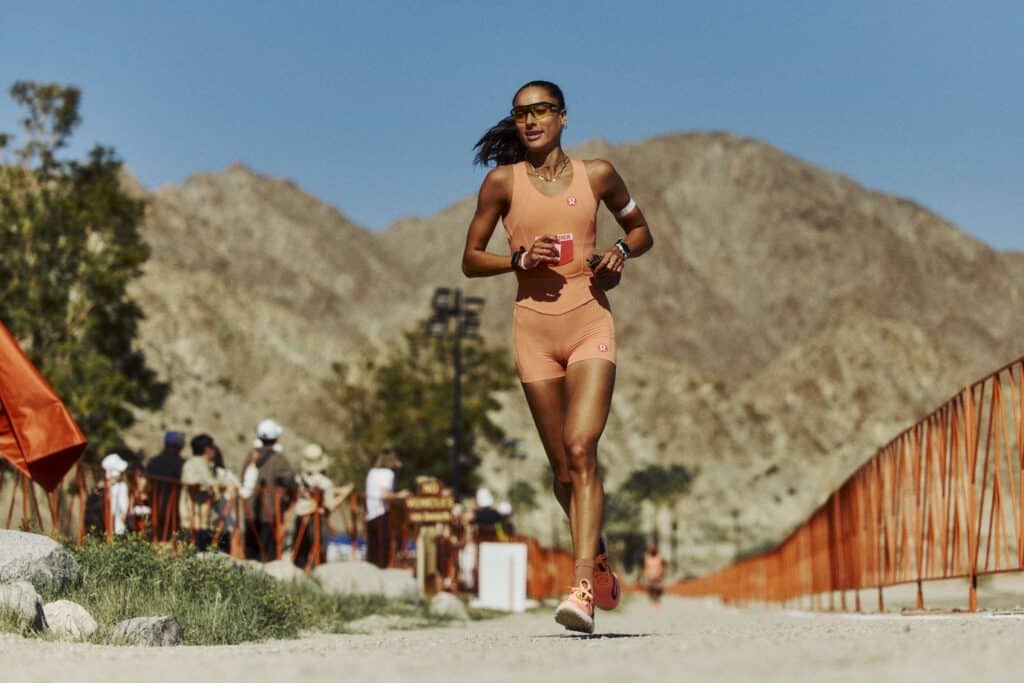If you pitted a professional male and female runner in a race against each other for a 5km, 10km, half-marathon or even marathon, most people would place their bets on the man winning.
But once you increase the distance beyond a marathon, the odds start to become more equal.
The gap between male and female performance has been shown to close as distances get longer– an exciting area of sports science research that is unfortunately lacking.
In an effort to fill this gap, a new initiative from apparel brand lululemon kicked off this month, which saw 10 female athletes gather in California to run their furthest distance and contribute to ultrarunning research.
Called the FURTHER ultrarun, the race included one of the most comprehensive in-race research efforts ever attempted, as part of lululemon’s scientific research program in partnership with the Canadian Sport Institute Pacific and the brand’s academic research network.
The overall program is aimed at better understanding human performance by advancing women-first research and helping close the sex and gender data gap in sports science.
Over the course of six days, the 10 athletes collectively ran 2880 miles (4,635km), with all surpassing their furthest previous distance. Multiple records were set on the 2.56 mile looped course that was measured and certified by the Association of International Marathons and Distance Races (AIMS).
Notably, US ultrarunner Camille Herron set a total of 13 records at FURTHER (pending ratification), including the Women’s Six-Day World Record at 901 KMs, Women’s World Best for 484km, 644km, 804km, 500km, 600km, 700km, 800km, 900km and Women’s World Bests for 72-hour, 96-hour and 120-hour times.
The groundbreaking event showcased just how far women can go with support and access to resources and product innovations typically reserved for men.
The ongoing research will continue to dive deep into questions such as whether female ultrarunners have superior fatigue resistance compared to males and other study areas that haven’t been explored, such as the lived experiences of women ultrarunners and the physiological and biomechanical effects of six days of running.
All findings will be published over the next two years, with initial findings to be published in the late 2024.
Montana Farrah-Seaton
Representing Australia in the group of ten was Melbourne-based Montana Farrah-Seaton, an ultrarunner, strength & conditioning coach, model and lululemon ambassador.
The 27-year-old covered an impressive 315.82 miles/ 508.26km over the six days.
Speaking to Women’s Agenda about her race, Farrah-Seaton says it “was a rollercoaster” and “one of the most gruelling yet transformative experiences”.
“Each day presented its own set of challenges, both physically and mentally,” she said. “I was filled with excitement and adrenaline on day one, but by day two my body felt like it was breaking down and I wasn’t sure if I could continue on.”
Farrah-Seaton says she began to question if she’d be able to finish the race, but luckily, day three brought “a renewed sense of purpose”.
“From day four onwards, there was an energy shift amongst all the women and it became less about the miles and more about the connection and being a team.”
Her preparation for this goal-defying ultramarathon took roughly a year, with Farrah-Seaton undergoing what she described as “a constant struggle to find balance between work and life” on top of her endurance and strength training.
And apart from the physical side of running, she notes that preparation for the race included priming herself mentally through visualising success and staying focused on her goals.
Like so many others, it’s this mental side of running that initially drew her in, along with the “sense of freedom and exploration it brings”.
“I often found clarity in the midst of movement and running quickly became a form of mediation, a way to solve problems and even a means of creative inspiration,” says Farrah-Seaton, noting that transitioning into ultra-length races also allowed her an opportunity to discover the depths of her determination and resilience.
“To any woman thinking about signing up for her first ultramarathon, I would say go for it,” she says. “It’s an incredible journey of self-discovery and empowerment that will push you beyond your limits and show you just how strong you truly are.”
Paving the way for future generations of female athletes was the biggest draw towards joining the FURTHER ultramarathon and contributing to the research, Farrah-Seaton says.
“Historically, sports science has primarily focused on male athletes, overlooking the unique physiological differences and needs of female athletes.”
She hopes that the insights gleaned from this initiative will shine a light on the importance of studying women’s sports performance and health.


